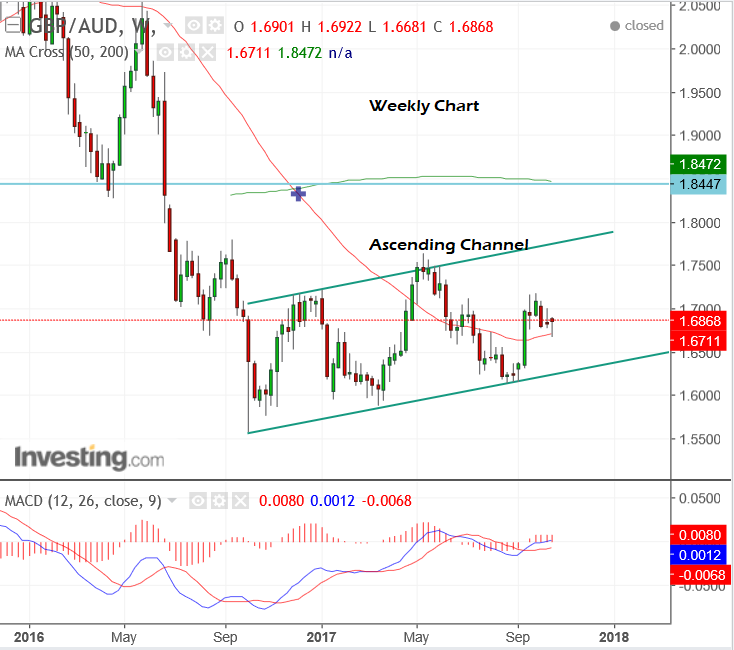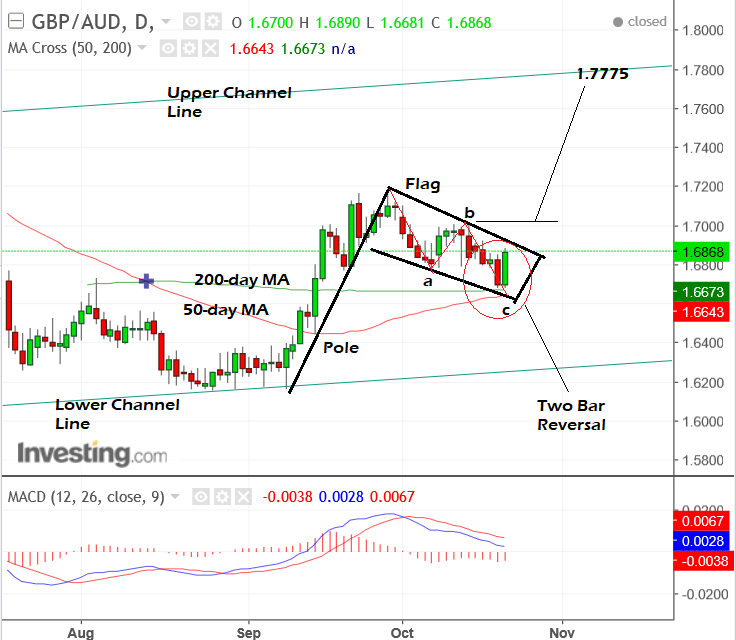Pound-to-Australian Dollar: A Bullish Setup on the Charts, Week Ahead Forecast
The Pound-to-Aussie rate could move higher this week as a lack of market-moving data down-under combines with an easing of fears over the Brexit negotiations and a bullish technical picture for GBP/AUD.
After bottoming in October 2016, the Pound-to-Australian Dollar has been moving steadily higher in an ascending channel that is visible on a weekly chart.
Whilst the channel looks somewhat vulnerable, it continues to rise steadily and within it, the exchange rate is also rising and showing bullish potential.
The daily chart (see below) shows a possible bullish flag pattern, which would suggest a break higher is on the horizon and an extension of roughly the same length as the 'pole' is likely, with a probable end-target at the upper channel line at 1.7775.
Furthermore, the pair has just completed a three-wave abc correction (see chart) after peaking in late September, and given the correction is finished, we would now expect a move higher to evolve.
Abc patterns are made up three waves which fall in a zig-zaging corrective pattern in which the first and third waves are normally of a similar length, and once finished the previous uptrend resumes.
In addition, the Pound-to-Australian Dollar exchange rate has formed a two-bar reversal pattern during its last two days (circled), which is when the exchange rate falls in a long red bar and then rises on the next immediate period in an equally strong green up bar.
These patterns are bullish indicators.
The location of the two most significant moving averages - the 50 and 200-day MAs - at the lows of the two bar reversal are further evidence that the exchange rate is likely to rally because these moving averages provide underpinning support to the exchange rate which is, therefore, more likely to rise.
MA's also present formidable obstacles to further downside due to short-term traders using them to trade counter to the dominant trend in expectation of prices being rebuffed by them.
Get up to 5% more foreign exchange by using a specialist provider by getting closer to the real market rate and avoid the gaping spreads charged by your bank for international payments. Learn more here.
Data, and Events that Could Move the Australian Dollar
The Australian Dollar was supported in the previous week by outflows from New Zealand following the election - outflows which sought a home in Australia, providing an explanation for why AUD/NZD rose to a 17-month high.
Australian data, especially employment data, is particularly strong at the moment, suggesting the Reserve Bank of Australia (RBA) may not be able to keep their avowed neutral stance for as long as they said, however, there were no signs in the monetary policy meeting statement last week to suggest a hawkish shift has occurred yet.
Looking ahead, the main release in the coming week is inflation data, out at 1.30 BST on Wednesday, October 25.
Inflation is forecast to rise to 2.0% year-on-year from 1.9% previously, which means compared to Q3 in 2016.
Quarter-on-quarter (which means compared to the previous quarter, or Q2 in this case) the inflation rate is forecast to rise by 0.8% compared to 0.2% in Q2.
"Australian inflation data is scheduled for release and while important we're not sure how much impact it will have on AUD as the RBA maintains a firmly neutral policy stance," said BK Asset Management's Kathy Lien, in relation to this release.
Data, and Events that Could Move the the Pound
Politics will still figure highly for Sterling in the week ahead.
Whilst the EU decided at their summit last week that not enough progress had been made to move to phase 2 discussions on trade, there was a silver lining in the form of EU Council President Donald Tusk who was optimistic about a deal.
Tusk said he thought descriptions of talks as being at "deadlock" were exaggerated, that the EU would start internal preparations for phase 2 as a concession to the UK, and that he hoped the second phase would begin in December when the EU will have another summit to decide whether to go ahead with phase 2.
The Pound recovered on Tusk's more optimistic comments after having sold off almost all week, and we think there is a chance of a 'Tusk bump' on Monday as the market starts to see a light at the end of the Brexit tunnel.
Tusk’s optimistic tone regarding Brexit was mirrored by the leader of Europe’s largest economy; Germany’s Angela Merkel suggested much of the gloom and angst surrounding Brexit is a function of British media coverage.
Merkel’s view is that talks are certainly not in deadlock.
We agree that media and markets are prone to focussing on the negatives at the expense of the more optimistic elements of talks. A classic example is the fixation with EU lead negotiator Michel Barnier’s use of the word ‘deadlock’ following the fifth round of talks. Barnier did also say he believed a breakthrough was still likely before year-end.
The Pound was sold and newsprint almost focussed purely on the negative, this leaves the Pound relatively oversold and prone to upside corrections when reality dawns.
The main hard data release for the Pound will come in the form of the first release for third quarter GDP, out at 9.30 BST on Wednesday, October 25.
The consensus estimate is for GDP to grow at 0.3%, but the result could make the difference between whether the Bank of England (BOE) hikes rates or not in November.
"PMI data suggest the GDP numbers will show another lacklustre 0.3% expansion in the three months to September, matching the performance seen in the first half of the year. Even such a modest GDP expansion would be unlikely to change the views of the hawks on the Monetary Policy Committee, but a weaker number could lead to rates remaining on hold at the November meeting. A stronger number would be seen by many as sealing the deal on a hike," says Bernard Aw, Principle Economist at IHS Markit.
Get up to 5% more foreign exchange by using a specialist provider by getting closer to the real market rate and avoid the gaping spreads charged by your bank for international payments. Learn more here.


